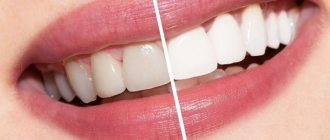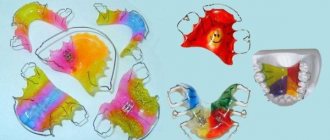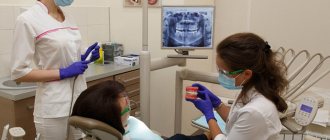No one doubts that every tooth in the mouth is important. The only exception is the “eight”. Their absence does not cause any functional disorders, does not affect the aesthetics of a smile or the ability to chew food. All other teeth are necessary so that the dentofacial apparatus can work as a single coherent mechanism.
With the help of incisors we bite off food, canines and premolars are used to grab food, molars are used to crush and grind food. The loss of any of these teeth inevitably leads initially to discomfort, various functional inconveniences, and later to deformation of the dentition.
Increased load on other teeth
In the absence of any teeth, their function is taken over by neighboring teeth, and accordingly, the load on tooth enamel, crowns and roots increases significantly. This leads to the fact that teeth begin to deteriorate many times faster. For example, when removing molars, the incisors have to take on a task not provided for by nature - grinding food. As a result, longitudinal and transverse cracks appear on the enamel, the edges of the teeth wear off and turn yellow.
Increased load over time turns out to be fatal for the roots, as it provokes their increased mobility. If you do not reduce the constant pressure, bone tissue will also begin to suffer from overload.
Possible causes of complete edentia
There are quite a few reasons that cause the loss of all teeth. Basically, these are advanced diseases of the oral cavity, which lead to the need to remove mobile, diseased, and sometimes even rotting teeth. Often a provoking factor is also the patient’s health, which does not allow maintaining high-quality oral hygiene, as well as the good condition of the teeth and gums.
Other factors include the following:
- genetic predisposition: manifests itself in the weakening of the ligamentous apparatus, which ensures the retention of teeth, in the gradual destruction of bone tissue, etc. In such a situation, it is very difficult to prevent the process, and prosthetics on implants becomes the only option to solve the problem,
- age-related changes: tooth loss occurs due to changes in hormonal levels, lack of vitamins and minerals, destruction of the skeletal system, disruption of tissue nutrition,
- consequences of diseases: mainly associated with serious illnesses. Some drugs reduce immunity, reduce the amount of minimal substances in the body, which leads to weakening of the ligamentous apparatus, loss of bone tissue and, accordingly, the teeth themselves,
- mechanical impact: teeth may fall out due to injury or mechanical damage,
- Negligent attitude towards the condition of the oral cavity: this reason is manifested in the fact that the patient does not carry out high-quality oral hygiene and ignores diseases that lead to tooth loss. This may be due to either a fear of doctors or a reluctance to spend time, effort and money on solving the problem.
Important! The main reason for the loss of all teeth is considered to be inflammation of the periodontal tissues, namely periodontitis and periodontal disease. These are dangerous diseases that usually spread throughout the entire range. As a result of weakening of the ligamentous apparatus, mobility occurs, and over time, complete loss of all teeth.
Bone loss
After a tooth is removed, the bone tissue begins to atrophy. Bone volume decreases by 25% per year, and the process is not as harmless as it might seem at first glance. Bone atrophy can cause adjacent teeth to become loose and even fall out.
Bone loss also creates problems with subsequent prosthetics. If a tooth is missing for too long, doctors have to perform a bone grafting procedure before installing an implant. This significantly increases the overall treatment time and cost.
Causes of tooth loss
- Periodontal diseases (may be a consequence of general disorders of the body)
- Caries and its complications (pulpitis, periodontitis)
- Injury
- Other reasons
The main motivation for dental treatment in patients with tooth loss, regardless of the cause and scale of the problem, are:
- decreased smile aesthetics
- loss of chewing efficiency
Diagnostics is the first and key step in the treatment of tooth decay and loss. Do you want to know why it’s impossible to do without diagnostics?
But, in fact, the loss of even one tooth, in addition to a banal deterioration in the quality of chewing food, can lead to a number of not obvious at first glance, but very serious and global problems. Because, one way or another, it will lead to disruption of the biomechanics of the entire human body.
Normally, if all the teeth are present in the mouth, at the moment of closure, the muscles that lift the lower jaw press it against the upper jaw. The force developed by the muscles through the upper jaw and temporomandibular joint (TMJ) is further distributed throughout the entire skull.
In this case, the general vector of muscle effort is located in the middle of the upper jaw, at the level of the first upper molars. Under such conditions, the main part of the muscle effort (about 70%) will be on the chewing teeth, and a smaller part (about 30%) will be on the TMJ area.
But when the teeth are closed, it is not only the muscles that elevate the lower jaw that contract. To create a balance of forces exerted by the muscles on the skull, the muscles of the neck, the muscles of the suboccipital region and many other muscles also contract. Along the chain, from top to bottom, to the very feet. And the integrity (when all the teeth are in the mouth) and symmetry of the dentition make it possible to maximally balance the above-described muscle efforts.
During a direct examination by a specialist, you will be able to find out your exact diagnosis, as well as receive a referral for diagnosis or a treatment plan.
According to statistics, the first molars (6th teeth) are most often removed, because... They are the first of the permanent teeth to erupt. And, accordingly, they are the first to be exposed to the aggressive effects of the oral cavity and the development of the carious process. Due to their location, these teeth are the main support for the lower jaw when the teeth are closed. And in the absence of these teeth, the muscle balance when closing is disrupted. The main part of the force from the masticatory muscles begins to be distributed to the TMJ, leading to its functional overload with the subsequent development of a pathological process in it. The teeth remaining in the oral cavity also experience overload, because... anatomically not adapted to bear the excess load redistributed to them. This will be manifested by the formation of wedge-shaped defects on the remaining teeth, exposure of the necks of these teeth, atrophy of the bone tissue around them, and pathological abrasion of their enamel.
If we take a hypothetical absolutely symmetrical person with full dentition, then when his teeth are closed, the effect of the muscles that lift the lower jaw on the skull will be balanced by the muscles of the neck, suboccipital muscles, etc.
The ideal distribution of chewing load with full dentition (a complete set of teeth) stabilizes posture.
In the absence of the masticatory group of teeth on one side, the masticatory muscles of that side will contract more strongly in order to bring the lower jaw on that side into contact with the upper. To counterbalance this force, the neck muscles on that side will also contract more forcefully, causing the head to tilt and the shoulder to rise on that side. This asymmetry will spread further down the body all the way to the feet.
The consequences of this asymmetry for the body are very dire. Starting from various pain syndromes due to overload of overly tense muscles and ending with irreversible structural changes in the form of herniated intervertebral discs.
In the absence of a chewing group of teeth on one side, an imbalance in the muscle balance will lead to the development of asymmetry of the entire body - scoliosis.
Lack of proper support in the posterior region will lead to overload of both TMJs and the remaining teeth. Trying to balance the symmetrically increased forces of the masticatory muscles, the muscles of the back of the neck will contract intensely, which will lead to the formation of a forward position of the head, which is fraught with the development of headaches (due to pinching of the suboccipital nerve), impaired cerebral circulation (due to pinching of the vertebral arteries) and etc.
Bilateral symmetrical absence of the chewing group of teeth will lead to a violation of the symmetry of the body in the anteroposterior direction.
Wear of the remaining teeth and degenerative changes in the TMJ area will eventually lead to a posterior displacement of the lower jaw, which can lead to compression of the upper respiratory tract, especially at night (sleep apnea syndrome).
All these consequences do not develop instantly, but over time. And therefore they can form relatively unnoticed. However, it should be understood that the longer this situation persists, the more difficult it is to reverse it. Long-term persistence of muscle imbalance caused by missing teeth can lead, as previously mentioned, to irreversible anatomical changes in the body. Moreover, if this condition exists for a long time, its complications can acquire a character independent of the original cause. In other words, if this imbalance is eliminated in a timely manner, all changes in the body caused by it will be eliminated automatically over time. If you seek help later, eliminating these complications will require additional efforts.
Timely, rational prosthetics of missing teeth will avoid these irreversible consequences and reduce the time and money required for rehabilitation. Advanced cases (cases of long-term absence of teeth) require the mandatory participation of non-dentist specialists, who will have to eliminate the persistent consequences of the described pathological process that have arisen in the body.
Orto-Artel specialists have extensive experience in the treatment and rehabilitation of patients with partial or complete loss of teeth. Including those who have developed the complications described above. After all, it is an integrated, holistic approach and joint thoughtful efforts of dentists, general practitioners and chiropractors, based on clear diagnostics and analysis of the data obtained, that allow us to solve problems of dental prosthetics of any degree of complexity.
Teeth become crooked
If one, or even more so, several teeth are missing, occlusion, the correct closure of the teeth of the upper and lower jaw, is disrupted. This is inevitable even if only one tooth is lost. The opposing tooth becomes unsupported and becomes loose. Teeth adjacent to the lost one converge in an effort to fill the empty space. The entire row of teeth gradually begins to move, the bite is disturbed, after which the impact on the jaw joint appears, causing headaches and neck and back pain.
If the teeth are not replaced with dentures, the gaps between them begin to increase, food will get stuck in these crevices, causing caries and other diseases.
Why might a tooth fall out?
There are many problems that can lead to hair loss. Among them there are genetic ones, as well as those that you simply cannot influence on your own. But much more often, troubles begin due to advanced diseases. If a person regularly visited a doctor and received treatment, they could have been avoided.
Caries
The vast majority of people in the world experience dental caries. This disease leads to the destruction of the dental crown. The root system also suffers - it becomes noticeably weaker.
Caries takes a long time to develop and reveals itself through noticeable external signs. Therefore, in most patients the problem could be avoided. At the same time, for some reason, a person puts off visiting the dentist until the last minute and often suffers pain.
As caries develops, the crown is gradually destroyed. It begins to split until it finally falls apart.
The problem is that in this case the root remains in the gum. If you do not remove it in time, there is a high probability that severe inflammation will begin to develop.
It is worth closely monitoring the appearance of the first signs of the disease. These include:
- Development of carious cavities. These are small spots or gaps in the enamel. They are often very difficult to notice from the outside because cavities develop on the inside of the teeth or between them.
- Increased sensitivity when eating food. Often there may be a strong reaction to salty, sour, hot, cold foods.
- Significant pain with pressure. Often a person simply cannot chew food normally. Sometimes the pain may, on the contrary, decrease when pressing on the tooth.
With severe caries, the tooth begins to turn black, and an unpleasant odor appears from the mouth. However, if you miss such signs, you will be faced with severe crown destruction.
Periodontal disease
Another very common disease. As it develops, it begins to affect the gums, and also affects the bone tissue located in close proximity to the tooth.
As the disease progresses, atrophy of the gum tissue occurs. A pocket begins to appear - there is a constant accumulation of bacteria in it. At the same time, severe inflammation actively develops - it is this that ultimately leads to tooth loss.
The tissue around the tooth begins to thin out and becomes weaker and weaker. The tooth becomes loose and then falls out.
To recognize periodontal disease in time, you should pay attention to several main signs. Among them are the following:
- Increased tooth sensitivity.
- Noticeable external manifestations of inflammation are the appearance of tissue swelling and redness.
- Bad breath.
- Instability, loosening of the tooth.
It is important to understand, as in the case of caries, the real danger of losing a tooth due to periodontal disease arises only if you do not contact the dentist for a long time and do not solve the problem.
Periodontitis
Periodontitis is the process of inflammation of the soft tissues of the mouth. It leads to the fact that the ligamentous apparatus becomes increasingly weaker. In this case, inflammation of the tissues is observed - the teeth simply can no longer withstand heavy loads while chewing food.
There are many causes of periodontitis. These include:
- Mistakes in oral hygiene.
- Injury to the gums.
- Violation of hormone metabolism.
- Decreased immunity.
- Active proliferation of bacteria.
It is important not to miss the first signs of the disease, which begins to manifest itself at a very early stage. Particularly noticeable signs are severe bleeding of the gums and a feeling of inflammation.
Your mouth begins to smell unpleasant, and you will feel noticeable discomfort when chewing food.
In the later stages, you may encounter purulent discharge from the gums.
Periodontitis can affect both the area of one tooth and spread throughout the oral cavity. The danger is a severe form, in which the teeth begin to loosen.
Other causes of tooth loss in adults
Aging is also a common cause of tooth loss. There are many reasons for this - from decreased immunity to gum atrophy. Besides aging, there are many other external potential causes:
- Diabetes . When blood sugar levels are disturbed, there is a strong increase in glucose levels. In this case, the tooth falls out due to problems with blood circulation in the gums.
- Diseases of the cardiovascular system . Often such diseases are accompanied by a deterioration in the condition of the oral cavity. This phenomenon can develop while taking certain types of medications.
- Poor oral hygiene . If you do not take proper care of your oral cavity, you may encounter bacterial growth and many other similar problems.
- Bad habits . Smoking, alcohol and drug use have a particularly negative effect on the condition of teeth.
There are also many other reasons - injuries, metabolic disorders, decreased immunity.
What are the dangers of missing teeth?
Many people perceive tooth loss only as an aesthetic defect that prevents them from smiling normally if there are not enough units in the smile zone. However, the consequences of long-term absence of teeth are much more serious and it is necessary to know them. This will help you not to delay solving the problem and consult a doctor at a time when dental restoration will be the fastest and least expensive. With prolonged absence of teeth, the following changes are inevitable:
- Increased load on remaining teeth. In turn, this leads to increased abrasion of the enamel, the appearance of cracks on it and pathological mobility of the dentition due to overload of periodontal tissue.
- Displacement of teeth, which can cause changes in bite and joint disorders in the jaw.
- Bone tissue atrophy. If a tooth is missing for a long time, atrophic processes can reach the point at which bone tissue augmentation is required before implantation.
- Functional disorders. The absence of several teeth on the sides gradually leads to a decrease in the height of the face in its lower part. As a result, a deep bite begins to form, interfering with proper chewing of food. The absence of incisors causes speech impairment and interferes with normal bite and swallowing of food.
- Violation of facial proportions. In the absence of molars, the cheeks begin to recede, and the removal of the front incisors leads to the retraction of the lips. If you do not restore your teeth for a long time, your face begins to sag in the area of the mouth and chin.
- Digestive problems. The absence of teeth makes it difficult to chew food well, and this negatively affects the functioning of the gastrointestinal tract, which can lead to gastritis, pancreatitis and other diseases.
Aesthetic problems, changes in diction, and digestive disorders that occur in people with missing teeth lead to psychological discomfort and low self-esteem.
Secondary consequences of edentia
Cosmetic defects and digestive disorders become noticeable almost immediately. However, there are also hidden consequences of untimely dental restoration.
In the absence of support, the tooth, which is an antagonist to the removed one, gradually moves out of the jaw. Over time, the neck of the tooth is exposed, and the tooth itself begins to sway from the slightest load. This threatens not only its loss, but also infection of the tissues surrounding it, because the space between the protruded tooth and the gum becomes an ideal object for pieces of food to get stuck and bacteria to multiply. Similar processes occur when other teeth in a row are displaced to compensate for voids.
Frequent inflammation in the oral cavity negatively affects the immune system, cardiovascular system and musculoskeletal system.
The absence of several teeth often leads to a sharp change in the bite and displacement of the lower jaw. This disrupts the functioning of the mandibular joint and provokes severe headaches and even disability.
For any degree of edentia, doctors advise planning implantation as early as possible. Missing teeth is not a cosmetic problem, but a complex problem! Call: +7 (8342) 222-888, sign up for a consultation, and our specialists will help you restore your dental health.
We live in a new way with new teeth: how life changes after implantation
Consequences of tooth loss and how to treat it
The long-term absence of one or more teeth leads to negative consequences for human beauty and health. Therefore, if you lose teeth, it is very important to consult a doctor in a timely manner for prosthetics.
There are not many lucky ones who managed to keep all their teeth intact by adulthood. The reasons for the loss of one or more teeth are most often injuries, dental diseases, and consequences of an unhealthy lifestyle. And here it is important to understand that if you do not make efforts to restore the dentition, this can have rather dire consequences. Starting with a seriously damaged appearance, and ending with deteriorating health and reduced life expectancy.
Consequences of missing teeth
Not only the loss of several or even all teeth, but also the loss of one tooth has a negative impact on the quality of life. Unfortunately, this problem is often perceived solely in the context of aesthetics. However, in fact, the lack of teeth has much more significant consequences, both for the condition of the oral cavity and for the entire body as a whole.
Digestive disorders Lack of chewing teeth leads to serious problems with chewing function, since the food taken is not ground properly. Over time, the digestive system begins to suffer, and diseases of the gastrointestinal tract may develop. In addition, due to the inability to chew food properly, the diet becomes more limited. As a result, the body lacks the nutrients necessary for full functioning.
Malocclusion When one or more teeth are lost, a violation of occlusion inevitably occurs - the correct closure of the lower and upper teeth. Moreover, similar results entail the loss of even one tooth. Neighboring teeth gradually shift towards the vacated space, then almost the entire dentition begins to move. And if bite correction and prosthetics are not started in a timely manner, the process will begin to have a negative impact on the maxillotemporal joint. As a result, quite unpleasant painful sensations in the joint, pathological abrasion of teeth, headaches, and pain in the cervical region may occur.
Accelerated destruction of other teeth If teeth are lost, it is necessary to perform prosthetics in a timely manner. Otherwise, the displacement of teeth into the vacant space will provoke the appearance of enlarged spaces between the teeth. This will affect oral hygiene: food will begin to linger in the gaps, which will lead to the active development of pathogenic bacteria. As a result, the risk of caries and other dental diseases will increase.
Gum disease In place of lost teeth, jaw bone tissue deteriorates. However, along with them, the gums are also destroyed. At the same time, the epithelial layer becomes thinner, forming a deep groove in place of the gum. Such defects can seriously deteriorate the aesthetics of the dentition and complicate the further procedure of dental prosthetics.
Aesthetics and psychology The absence of a tooth or teeth in the smile area disrupts its natural beauty. Psychological problems become an almost automatic consequence. A person begins to feel embarrassed to talk in society, including when communicating with work colleagues, friends or relatives. This inevitably leads to a decrease in self-esteem and the emergence of psychological complexes, which turns into a serious stress factor. Ultimately, this can negatively affect not only the quality, but also the life expectancy.
Speech disorders The absence of one or more front teeth is not only psychological discomfort due to an ugly smile. Another unpleasant consequence is speech impairment, since the front teeth are used in articulation. Violation of normal speech function also often becomes a reason for ridicule from others and for the appearance of complexes and stress in a person.
Changes in appearance In place of lost teeth, the jawbone ceases to experience stress and gradually becomes thinner. That is why, when deciding on dental implantation, it is necessary to perform a procedure such as sinus lift - artificial bone tissue augmentation. Over time, degradation of the jaw bone can change facial features: the corners of the mouth droop, the lips sink, and the lower jaw visually becomes smaller. A double chin may appear, accompanied by the formation of wrinkles on the neck. As a result, a person sometimes looks significantly older than his age.
Restoring missing teeth
It is obvious that the possible consequences of tooth loss are quite serious. Therefore, it is very important to take timely steps to restore the dentition. Moreover, both orthopedic dentistry and implantology have many effective means for solving this problem.
Prosthetics for partial loss of teeth A wide range of modern solutions are used for partial prosthetics. The most commonly installed bridges and clasp prostheses, prostheses on implants. The most progressive method is dental implantation, which offers the most reliable and aesthetic solutions. It is even possible to immediately implant teeth, allowing you to solve the problem in the shortest possible time.
The key advantages of implant prosthetics include the long service life of the dentures and the absence of the need to grind down adjacent healthy teeth. And, most importantly, such a denture almost completely replaces a natural tooth, restoring not only the aesthetics of the dentition, but also its chewing function. The only drawback is the relative high cost of the implantation procedure.
Prosthetics for complete loss of teeth In case of loss of all teeth, removable or fixed prosthetics are possible. The cheapest option is considered to be removable acrylic dentures, which have many disadvantages. Modern removable silicone or nylon dentures are more expensive, but much more functional and easy to use. However, removable prosthetics are in any case inferior to fixed prosthetics according to all key criteria.
The main option for fixed dental prosthetics is the installation of orthopedic structures supported by implants. At the same time, complete implantation of all teeth is performed quite rarely, since it is an extremely expensive and complex procedure that has many medical contraindications. As a rule, clasp or other orthopedic structures are installed with support on implants. To achieve this, it is usually sufficient to install 4-6 implants in each jaw. This option is a compromise in price and functionality, and allows you to effectively restore the entire dentition.
Summary
The consequences of a long-term absence of one or more teeth can be quite sad. A person’s external attractiveness is lost, the quality of life in general deteriorates, and significant damage is caused to the body. Therefore, it is very important to take proper care of your dental health: take oral hygiene seriously and visit the dentist promptly.
If tooth loss cannot be avoided, there is no need to despair. Modern dentistry is quite successful in restoring both one or more lost teeth and the entire dentition. You just need to contact a specialist in time, without delaying or waiting for negative consequences.











